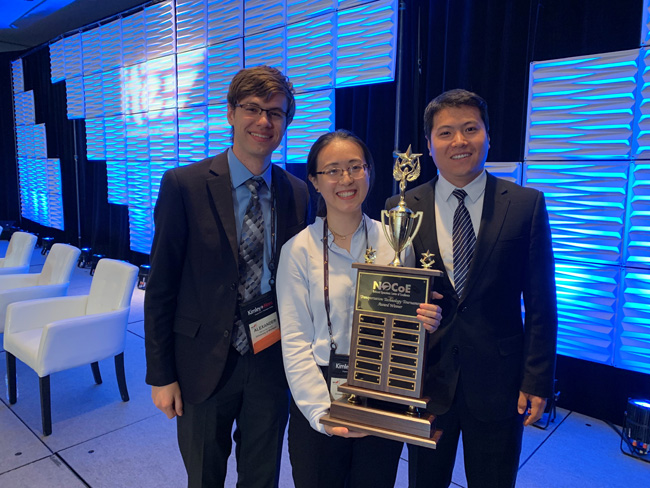
A team of students from the
In an impressive display of single-minded commitment, they delivered a well-executed ten-minute presentation they’d spent months perfecting.
One of five groups invited to present at the
While not as notorious as the 405 in Los Angeles or the Beltway around Washington, DC, anyone who has travelled I-75 or I-696 during the Motor City’s rush hour is likely familiar with their metropolitan Detroit counterpart.
Complex concepts
With strong ingenuity and communication, the Michigan team members discussed peak usage hours and how congestion could be reduced using ITS technologies combined with transportation systems management and operations (TSMO) strategies.
Patrick Son, managing director of NOCoE, said the competition was designed to grow the students’ communication and presentation skills, but also to address workforce issues. “All of these students are the future of our industry,” he said. “Their engineering skills are already strong but for most, this was their first exposure to taking complex concepts and whittling them down to essential and compelling details, the kinds of skills that will be crucial when they present to industry leaders and agency decision-makers in their future.”
Other finalists at the event included teams from the University of Tennessee, Knoxville, who proposed using data from the traffic conditions app,
The University of Michigan’s winning team applied a ‘supply and demand’ approach to their solution. On the supply side, their proposal included managing the flow of vehicles through a combination of ITS and TSMO initiatives, particularly at the critical moment when vehicles merge into highway traffic.
Car-pooling strategy
On the demand side, they addressed the number of occupants in each vehicle, proposing a shuttle and car-pooling strategy in collaboration with General Motors and Chrysler, the I-75/I-696 area’s two largest employers. Team members Alex Sundt, Yan Zhao and Xiatong Sun who participated during the tournament, said they were confident but surprised by their win. “We are very excited,” said Sun. “We had the confidence after yesterday’s rehearsal but today we listened to others’ presentations, and we thought they were also very good.”
Yan Zhao concurred: “We are used to solving equations and we are used to presenting in front of a lot of academic people but when we solve real-life problems, we have to present our solutions to people who may not be familiar with equations. We have to explain the details and our reasoning behind it. That will be really helpful in my future.”
The team received guidance from University of Michigan Civil and Environmental Engineering Department assistant professor Dr. Neda Masoud. Other team members participating in the project - but unable to attend - included students Edmond Huang, Guoyang Qin and Amir Tafreshian.
Necessary skills
Patrick Son says the contest was part of NOCoE’s commitment to ensure that the future workforce has the skills necessary to address the needs of the rapidly evolving transportation system.
“Workforce is one of the most important issues our industry is facing. Transportation is changing almost daily and so are the skills necessary to maintain a robust and appropriately trained workforce,” he said. “Academic institutions are doing an outstanding job of preparing engineers, planners and technologists, but we need to make sure the next generation of transportation leaders also come equipped with crucial communication and presentation skills.”
NOCoE’s workforce initiatives include: working with student ITE chapters to develop ePortfolios, supporting the development of a comprehensive guidebook to grow the TSMO workforce that contains position descriptions, recruitment and retention techniques, and career development strategies (available at www.transportationops.org), providing a TSMO training database (also on the website), as well as maintaining an ongoing partnership with US DoT’s Professional Capacity Building programme (PCB) to identify and address the needs of academia and employers.
Earlier this year,
Those initiatives are crucial for the road forward and they will require an adaptive, nimble, and well-trained workforce. Workforce issues have become a cornerstone issue at the American Association of State Highway and Transportation Officials (AASHTO).
Future optimism
AASHTO 2018-2019 president and
Back in Austin, there was reason for optimism about the next generation of transportation engineers. Each of the university teams impressed the judges by developing solutions for the transportation challenges their communities have been living with for generations. Each group displayed a commitment to safety and sustainability, aligned perfectly with the path laid out by the smartest minds in the transportation ecosystem. Many of those smart minds were in the room as the students were introduced to more than 500 transportation leaders during an ITE plenary and awards session. But the awards and accolades are not the end of the story. At least two of the finalists and potentially more, may soon see their ideas become reality. The team from Florida International University is already working with Tampa to implement their wrong-way driving plan and a high level Tennessee DoT official confirmed he is interested in funding a pilot on the University of Tennessee’s Waze solution.






